I recently updated older posts about the cars and motorcycles that have been part of my life. I thought I’d written a separate post about the aircraft I’ve flown, but when I went looking, it wasn’t here. I found it eventually — on Facebook. I don’t know why I never included it on my own blog. It’s time to fix that.
As with the car and motorcycle posts, the photos in the first version of my airplane post weren’t very good, so I went looking for better ones. Some of these new photos are my own; a few are generic photos from other sources. Click on any of them to see the full-sized originals on Flickr.
I was 23 years old the first time I flew an airplane. It was 1970, and one of my college professors invited me to go up in his Piper J3 Cub. We took off from a grass strip south of Sacramento, California, and once airborne he gave me the controls and talked me through some basic maneuvers. I liked it. Flying seemed like something I’d like to do more of some day. Probably not too many medieval lit professors can afford to own an airplane today, but this gentleman did, and I’m forever in his debt.
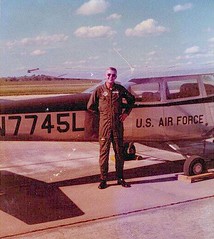 In the spring of 1973, when I was teaching in Glasgow, Montana, I enlisted in the Air Force. The air war in Vietnam was winding down but the replacement aircrew training pipeline was still running at full capacity and the USAF needed pilots. I took the pilot aptitude test and passed a flight physical, and started OTS (officer training school) that summer at Lackland AFB in San Antonio, Texas.
In the spring of 1973, when I was teaching in Glasgow, Montana, I enlisted in the Air Force. The air war in Vietnam was winding down but the replacement aircrew training pipeline was still running at full capacity and the USAF needed pilots. I took the pilot aptitude test and passed a flight physical, and started OTS (officer training school) that summer at Lackland AFB in San Antonio, Texas.
Part of OTS, at least for the pilot candidates, was a flight screening program. FSP was conducted at Hondo Airfield near San Antonio, and consisted of flying lessons in the military version of the Cessna 172, the T-41 Mescalero. I soloed after ten flights, as did half my classmates. The other half washed out: some for lack of aptitude, some for chronic airsickness. After Hondo, it was back to Lackland to finish OTS. I graduated as a butterbar (second lieutenant) in September 1973.
Donna and our son Gregory, who stayed with my parents in Missouri while I was at OTS, joined me at Vance AFB in Enid, Oklahoma for undergraduate pilot training. I was in UPT Class 7503, the third class scheduled to graduate in fiscal year 1975. UPT normally lasted a year, but partway through training our class was suspended, then restarted several weeks later with a different number.
What happened was the shutting down of the Southeast Asia replacement aircrew training pipeline. Vietnam was over and the military suddenly had a huge pilot surplus. During the stand down we were detailed as gophers to different organizations on base. The USAF had two choices: send the trainees home or initiate a RIF (reduction in force) to get rid of pilots it already had. The decision broke our way: the USAF decided on a RIF, and many of our instructor pilots were discharged.
We started flying again, now as members of Class 7504. Each class was allowed to design its own shoulder patch; ours was four aces overlaid with 7503, the 03 crudely crossed out, a scribbled 04 sewn above. Air Training Command almost vetoed that patch but eventually allowed us to wear it. Instead of finishing in September 1974, we graduated in December. We started with 60; 40 of us made it all the way through.
So what did I fly in UPT? Two jet trainers, the Cessna T-37 Tweet and the Northrup T-38 Talon. The Tweet was the primary trainer, the Talon the advanced one. We started in the Tweet, mastering takeoffs and landings, aerobatic maneuvers and recovery from unusual attitudes and spins, flying at night and under the hood, executing non-precision and precision approaches, filing flight plans and navigating cross-country, flying formation.
After six months in the Tweet we moved on to the Talon, polishing our skills in a supersonic trainer designed to fly like the Century-series fighters then in use. We trained in the era of the “universally assignable pilot”: the idea was that by teaching everyone to fly a fighter-like aircraft, any graduate could go on to fly the most demanding aircraft in the USAF inventory (the USAF had only mixed success with that; they do it differently these days).
 On graduation day in December 1974 we put on our blues and stood on the parade field, then pinned on our wings. Donna pinned me; my father and grandfather were there too. That night we put on our dress uniforms for a formal dinner at the officers’ club. Afterward, we were called one by one to a back room, where the training wing commander finally revealed to us what we’d be flying for the Air Force.
On graduation day in December 1974 we put on our blues and stood on the parade field, then pinned on our wings. Donna pinned me; my father and grandfather were there too. That night we put on our dress uniforms for a formal dinner at the officers’ club. Afterward, we were called one by one to a back room, where the training wing commander finally revealed to us what we’d be flying for the Air Force.
Traditionally, the top ten percent of graduates got their first choice of aircraft, and in those days we all wanted fighters. I was number four in my class and thus in the top ten, but due to the post-Vietnam drawdown only three fighter assignments were available. All three had been claimed by the time my name was called.
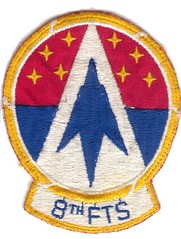 My destiny turned out to be Air Training Command and the Tweet: I’d been picked to be an ATC instructor pilot, assigned to the 8th Flying Training Squadron right there at Vance AFB, where I was to train students to fly the T-37. My tour with the 8th FTS was to last, after two months of pilot instructor training at Randolph AFB in San Antonio, three years.
My destiny turned out to be Air Training Command and the Tweet: I’d been picked to be an ATC instructor pilot, assigned to the 8th Flying Training Squadron right there at Vance AFB, where I was to train students to fly the T-37. My tour with the 8th FTS was to last, after two months of pilot instructor training at Randolph AFB in San Antonio, three years.
I admit was disappointed at first, but after PIT at Randolph and the first few months back at Vance AFB, the assignment began to grow on me. Over the course of three years I trained dozens of young men to fly. I got good at it, and before long I was a check pilot, evaluating students who had been trained by other instructors. I stood nervously by the runway supervisory unit while my studs flew their first solo patterns around the airfield, washed a couple of failing studs out, fought for others who stumbled but had potential, took pride in the ones who did well and moved on to the T-38 phase. Donna and I decided to have another child: the instructor pilot life was a stable one, with no temporary tours of duty and only occasional weekends away during the cross-country phase of training. It turned out to be a great first assignment, and it led me to fighters after all.
Just before the end of my time with Air Training Command, an ATC instructor pilot from another training base got a coveted Tactical Air Command F-15 assignment. This was unheard of — the Eagle was still new in those days and only experienced fighter pilots were selected to fly it. But in February 1978 this one guy got in, and then with our group, ATC instructors coming up for reassignment in March 1978, the dam broke: six of us were selected for F-15 training. We knew the Air Force was taking a chance on us and that we’d be under intense scrutiny. We worked hard to do well. We succeeded.
Before we could start flying the F-15, though, we had to go through fighter lead-in training at Holloman AFB in New Mexico. This was a two-month program designed to teach the basics of air-to-air and air-to-ground maneuvering and weapons delivery. As with PIT at Randolph three years earlier, I went to fighter lead-in by myself and lived in bachelor quarters on base. We flew modified T-38 trainers called AT-38s, capable of carrying and dropping small practice bombs. This was a kind of flying unlike anything I’d done before; tons of fun but also dangerous and hard, demanding total concentration.
Up to this point, every USAF aircraft I had flown, including the AT-38, had been a two-seater. We occasionally flew them solo, but almost always a student or another pilot was along for the ride.
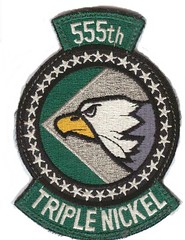 When I finished lead-in in July 1978, Donna and the kids and I rented an apartment in Phoenix, Arizona, where I was to go through F-15 training at Luke AFB. My classmates were the other five former ATC instructor pilots mentioned earlier.
When I finished lead-in in July 1978, Donna and the kids and I rented an apartment in Phoenix, Arizona, where I was to go through F-15 training at Luke AFB. My classmates were the other five former ATC instructor pilots mentioned earlier.
Our RTU, or replacement training unit, was the 555th Tactical Fighter Squadron (aka the World Famous & Highly Respected Triple Nickel, “largest distributor of MiG parts in Southeast Asia”). F-15 RTU was the hardest training program any of us had gone through, multiples tougher than pilot training. Yes, we had some initial instruction on basic fighter maneuvers from our AT-38 lead-in training, but none of us knew anything about radar or electronic countermeasures or air-to-air missiles; none of us had ever air refueled; none of us had ever pulled 7+ Gs in a dogfight — none of us really knew anything at all. It was like drinking from a firehose for four months. I struggled to keep up; I think we all did.
Our first few flights in the F-15 were in B models, the two-seat version of the F-15. After our instructors were certain we wouldn’t kill ourselves, we flew the F-15A single-seater, the instructor flying alongside in another A model. There was a lot of academics and a lot of simulator practice, but also lots of flying. About a month in, we learned where we were to be sent. Three of my former ATC instructor pilot classmates and I were going to the 32nd Tactical Fighter Squadron Wolfhounds at Soesterberg Air Base in the Netherlands, an F-4 Phantom II unit scheduled to convert to the F-15.
 After three months at Luke, we four Soesterberg-bound newbies were joined by our future squadron-mates, the experienced F-4 pilots from the 32nd TFS who’d been picked to fly the F-15. Coming from the F-4, they only needed to complete the “short course,” a dozen flights in the F-15. They showed up as a group just as we newbies entered the last month of the “long course.” It was a fantastic stroke of luck to train together and get to know one another before setting off for the Netherlands.
After three months at Luke, we four Soesterberg-bound newbies were joined by our future squadron-mates, the experienced F-4 pilots from the 32nd TFS who’d been picked to fly the F-15. Coming from the F-4, they only needed to complete the “short course,” a dozen flights in the F-15. They showed up as a group just as we newbies entered the last month of the “long course.” It was a fantastic stroke of luck to train together and get to know one another before setting off for the Netherlands.
After Luke, we went to Langley AFB in Virginia for a month of top-off training in overwater operations and NATO procedures; there we first flew our own 32nd TFS jets, fresh from the factory in St Louis. When we finished at Langley the experienced pilots flew the new jets over to Europe. The rest of us flew over on commercial flights, settled into the Dutch communities around Soesterberg AB, and got to work.
This is a photo of Steve Spencer and me flying over the famous windmills of Kinderdijk. Spence is lead and I’m on the wing. Bob Williams, the McDonnell-Douglas factory photographer, took the photo from the back seat of an F-15B model flying alongside.
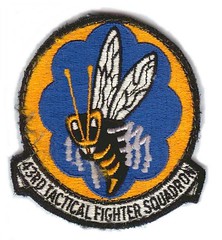 Halfway through the Soesterberg tour I became a two-ship flight lead, then a four-ship flight lead. In 1980 we swapped our slightly-used F-15A models for brand-new F-15Cs, an improved version of the Eagle, and I got to lead a four-ship across the Atlantic to turn our old jets in, then fly new ones back across the pond. Near the end of my tour I qualified as an F-15 instructor pilot; this enabled me to land a follow-on assignment to the 43rd TFS Hornets at Elmendorf AFB in Alaska, another unit about to convert from the F-4 Phantom II to the F-15 Eagle.
Halfway through the Soesterberg tour I became a two-ship flight lead, then a four-ship flight lead. In 1980 we swapped our slightly-used F-15A models for brand-new F-15Cs, an improved version of the Eagle, and I got to lead a four-ship across the Atlantic to turn our old jets in, then fly new ones back across the pond. Near the end of my tour I qualified as an F-15 instructor pilot; this enabled me to land a follow-on assignment to the 43rd TFS Hornets at Elmendorf AFB in Alaska, another unit about to convert from the F-4 Phantom II to the F-15 Eagle.
At Elmendorf we flew older F-15A models, some of them the same jets I trained on at Luke AFB a few years before. I was the second F-15 pilot to arrive in Alaska, and it was a few months before the two of us even had jets we could fly. Eventually, though, we did, and it was a fantastically fun assignment, especially intercepting Soviet aircraft above the Arctic Circle and over the Bering Straits.
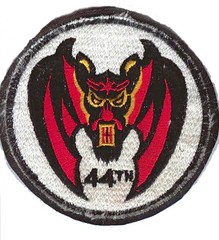 In 1985 the USAF sent me to the Armed Forces Staff College in Norfolk, Virginia, then on to MacDill AFB in Tampa, Florida, where I flew a desk for US Special Operations Command. That tour ended in late 1988, and it was time to return to the cockpit. The USAF wanted to send me to Iceland for a two-year tour flying F-15s, but another F-15 pilot asked to swap a three-year assignment in Japan for my Reykjavik slot and I jumped on it. Japan had always been on my bucket list.
In 1985 the USAF sent me to the Armed Forces Staff College in Norfolk, Virginia, then on to MacDill AFB in Tampa, Florida, where I flew a desk for US Special Operations Command. That tour ended in late 1988, and it was time to return to the cockpit. The USAF wanted to send me to Iceland for a two-year tour flying F-15s, but another F-15 pilot asked to swap a three-year assignment in Japan for my Reykjavik slot and I jumped on it. Japan had always been on my bucket list.
After requalifying in the F-15 at Luke AFB, this time in the short course, I went to Okinawa to fly F-15Cs with the 44th TFS Vampires at Kadena Air Base. Donna stayed in Tampa to sell our house, then joined me in early 1989. While at Kadena I was chief of wing plans, then the training division. I flew training missions from Kadena two to three times a week, interspersed with alert deployments to Osan AB in Korea, deployments to the Philippines (until Mount Pinatubo covered our base there in ashes), and toward the end of my time there a fantastic three-week deployment to RAAF Darwin to fly with the Aussies.
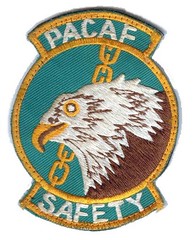 In 1992 we left Japan for Hickam AFB in Honolulu, Hawaii, and a tour as chief of flight safety for Pacific Air Forces. At PACAF, I supervised flight safety programs at our bases in Hawaii, Japan, Korea, Guam, and Alaska, as well as training detachments in Australia and Singapore. While there I oversaw the investigations of several major aircraft accidents, something my F-15 accident investigation experience at Soesterberg and Elmendorf had prepared me for. As chief of flight safety, I flew as an observer in all the different aircraft assigned to PACAF, traveling around the Pacific to inspect flight safety programs at our bases.
In 1992 we left Japan for Hickam AFB in Honolulu, Hawaii, and a tour as chief of flight safety for Pacific Air Forces. At PACAF, I supervised flight safety programs at our bases in Hawaii, Japan, Korea, Guam, and Alaska, as well as training detachments in Australia and Singapore. While there I oversaw the investigations of several major aircraft accidents, something my F-15 accident investigation experience at Soesterberg and Elmendorf had prepared me for. As chief of flight safety, I flew as an observer in all the different aircraft assigned to PACAF, traveling around the Pacific to inspect flight safety programs at our bases.
Upon leaving Hickam in 1995 we went to Nellis AFB in Las Vegas, Nevada. My assignment this time was to a non-flying position, supervising contractor activities on the Nellis ranges. I realized my flying days were over, and retired from the USAF in July 1997. All total I have a bit more than 3,000 hours flying time: 1,000 as a T-37 instructor pilot, nearly 2,000 as an F-15 pilot, the rest divided between my student pilot time in the Tweet, the Talon, and the AT-38.
I mentioned flying in a variety of USAF aircraft, but it was observer time and I was not at the controls, so I won’t include those aircraft here. I did get stick time, including landings, in two other fighters, so I will include those. Landings count, right?
The 32nd TFS hosted a Royal Canadian Air Force CF-104 unit for two weeks in 1980 while their runway in northern Germany was being resurfaced. I wrangled an invitation to go flying with their commander in one of their two-seat CF-104Ds. He basically gave me the stick after takeoff and let me fly to and from the range. Entering the traffic pattern at Soesterberg an hour later, I was surprised when he didn’t take the controls back. I expected him to do so at any moment, but since he hadn’t I kept flying as if I knew what I was doing. He let me fly it to touchdown, not an easy thing to do from the back seat. After landing he popped the drag chute, which could only be done from the forward cockpit, and took over. I’ll say this about the Zipper: its wings are so small it doesn’t react to turbulence like the big-winged F-15. Trim it up and point it, and it flies through the air like an arrow. What a blast.
Years later, during a PACAF flight safety inspection trip, I flew an F-16 two-seater at Misawa AB in northern Japan. The Viper pilot in the front seat flew us to the range, dropped a few practice bombs, made a couple of strafing passes, then handed me the controls on the way home. Once again I kept waiting for him to take the aircraft back and land it; once again I wound up landing an unfamiliar aircraft from the back seat. I thought I’d really like the isometric side-stick control of the F-16, but I didn’t — I missed the big tractor-like center stick of the Eagle. Otherwise, ditto in the blast department.
I haven’t mentioned civilian flying time. After my “dollar ride,” that 1970 hop in my professor’s Piper Cub, I didn’t fly another civil aircraft until I was a T-37 instructor pilot at Vance AFB. I thought I might as well get some FAA ratings in case I decided to go to the airlines some day, so on weekends I earned a commercial pilot certificate from a local flight school at Woodring Airport. Later on I became a certified flight instructor, taking my FAA check ride in a retractable gear Cessna 210, a fancy airplane I could never afford to rent on my own. Occasionally old friends from California would come visit us in Enid, and I’d fly section lines down to Oklahoma City to pick them up at the airport in a rented Cessna 152, which I could (barely) afford.
The owner of the flight school at Woodring Airport at one point bought a Great Lakes biplane trainer and I was the first person to enroll in his aerobatics course. I thought I knew all about aerobatics as a T-37 instructor, but the USAF didn’t let us fly negative G maneuvers in the Tweet, so a lot of what I learned in the Great Lakes was new to me. When I finished the course I was not just a CFI but an aerobatic CFI, and the flight school hired me as an aerobatic instructor. I made a little extra money on weekends taking civilian pilots up in the Great Lakes to teach them outside loops, hammerheads, and snap rolls. Negative G maneuvering is exhausting. Let me also say landing a taildragger is a hell of a lot different from landing a jet with tricycle gear. Have you ground-looped a taildragger? I have.
Donna and I loved every assignment and tried to get the most out of them, both professionally and personally. We enjoyed our time in Enid. While at Soesterberg we traveled all over Europe, plus trips to England and Scotland. We fished, skied, hunted, and camped in Alaska. We made Japanese friends in Okinawa and took side trips to Thailand, Hong Kong, and Singapore. We loved the laid back island life in Honolulu. Even though our days in the USAF were counting down to zero, we settled into Las Vegas, a surprisingly great town to live in, and had every intention of planting permanent roots there — that is until civilian opportunity knocked in Tucson, Arizona.
Topping everything else, though — at least for me — were those wonderful flying assignments and those beautiful airplanes. I’d do it all again, in a heartbeat. Hemingway said it best:
It is appearances, characteristics and performance that make a man love an airplane, and they, told truly, are what put emotion into one. You love a lot of things if you live around them, but there isn’t any woman and there isn’t any horse, nor any before nor any after, that is as lovely as a great airplane, and men who love them are faithful to them even though they leave them for others. A man has only one virginity to lose in fighters, and if it is a lovely plane he loses it to, there his heart will ever be.

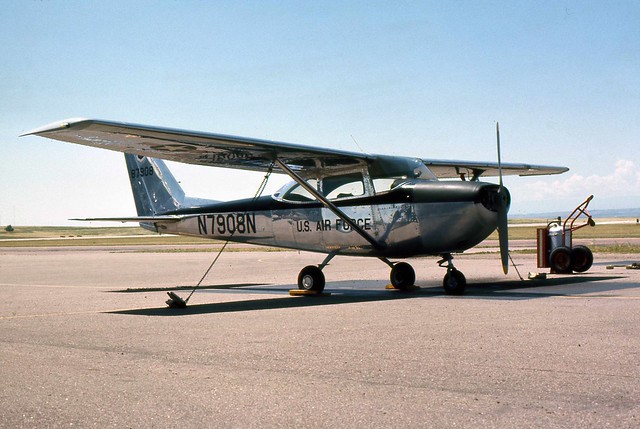
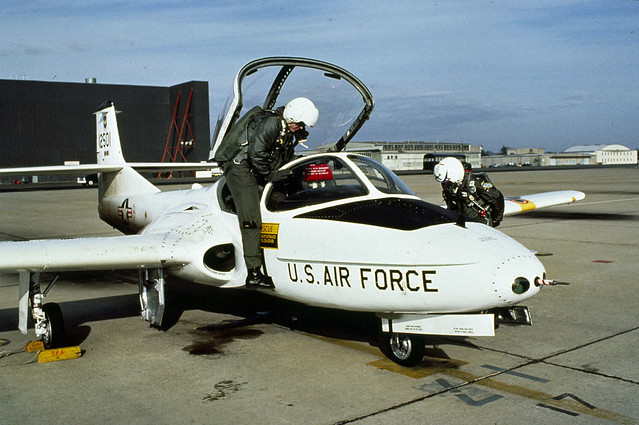
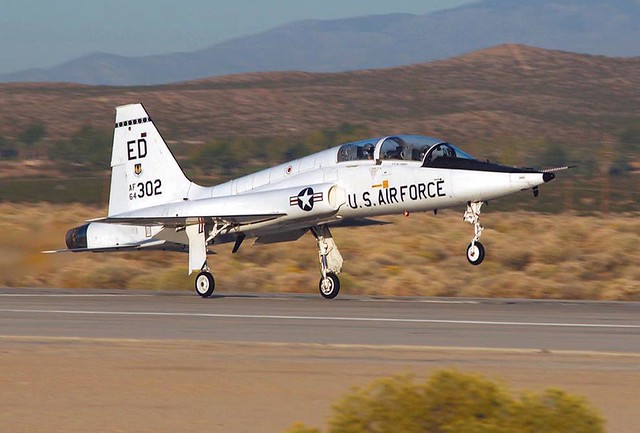
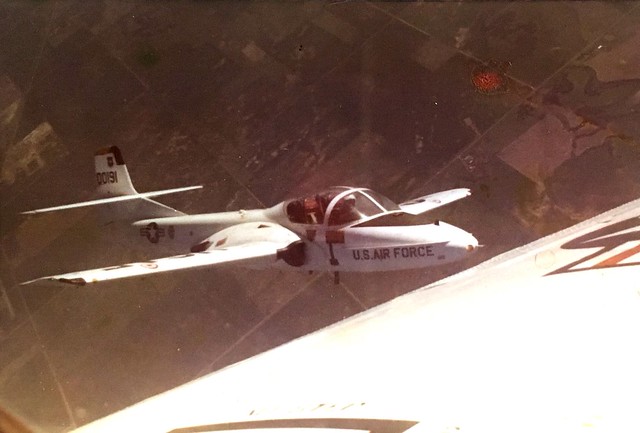
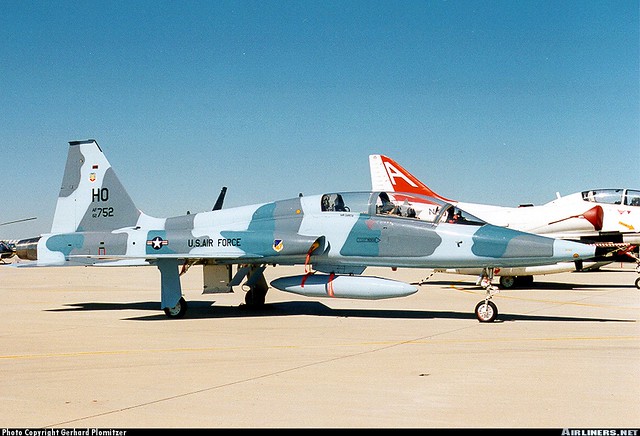

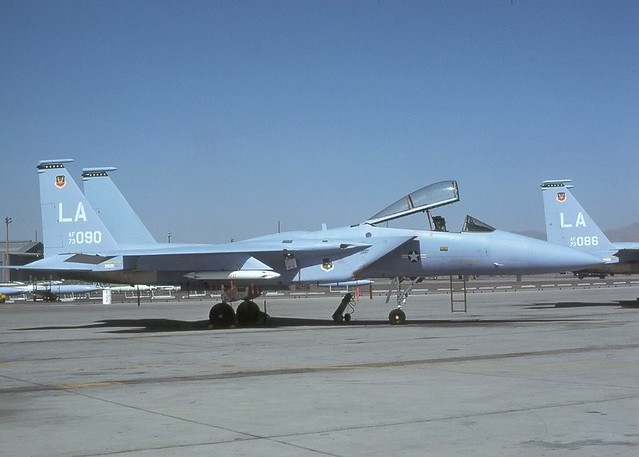
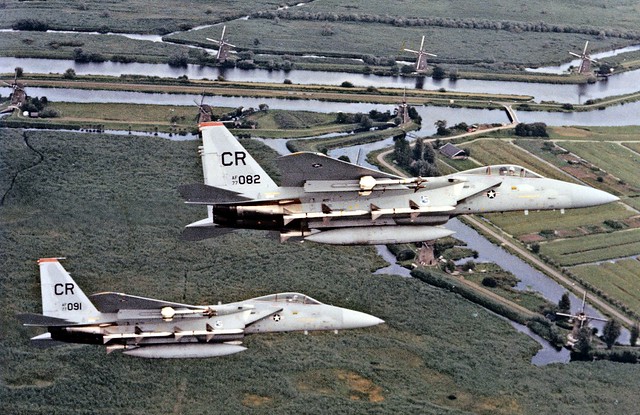
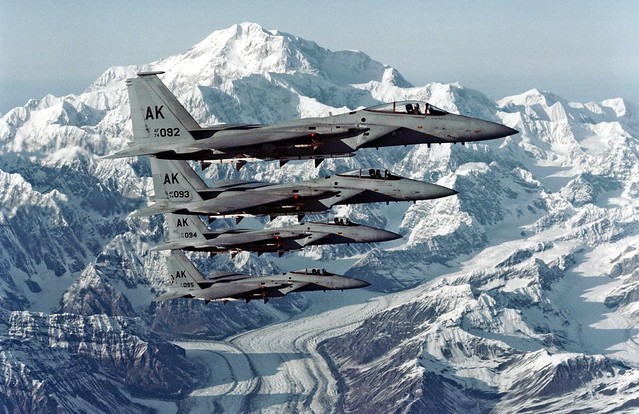


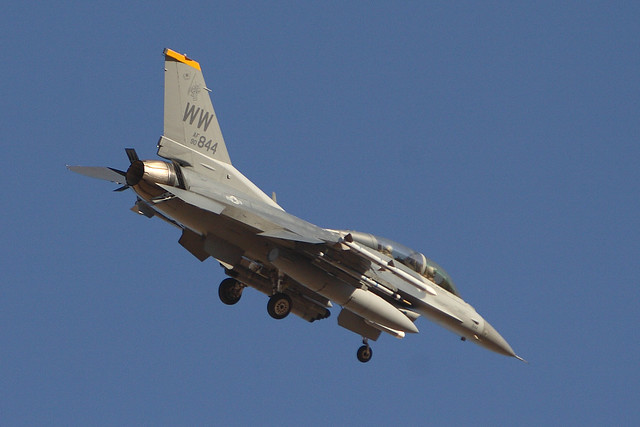


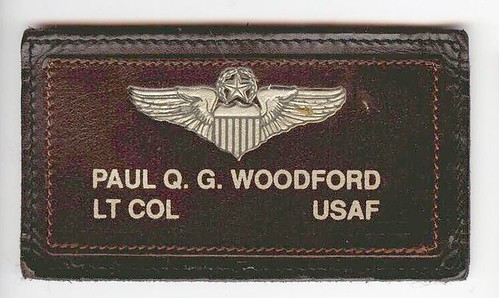
“Oh, I have slipped the surly bonds of earth, and danced the sky on laughter silvered wings; Sunward I’ve climbed and joined the tumbling mirth of sun-split clouds-
and done a thousand things you have not dreamed of – wheeled and soared and swung high in the sunlit silence.
Hovering there I’ve chased the shouting wind along and flung my eager craft through footless halls of air.
Up, up the long delirious burning blue
I’ve topped the wind-swept heights with easy grace, where never lark or even eagle flew; and
while with silent,lifting mind I’ve trod the high untrespassed sanctity of space, put out my hand and touched the face of God”
-John Gillespie McGee, Jr. (d. 1941) High Flight
Paul,
Thanks for taking me down memory lane. I too fussed about being a T37 IP at Vance. That first assignment also took me to fighters 3 different ones in total.
That terrified “stud” on your wing there is none other than me! Thanks for teaching me how to do that. It paid off.
B-Square
Received this email comment today:
“I like your attitude and candid politics. You described your first flight .. how about you current flight status.”
My current flying status is grounded. I chose not to go to the airlines after leaving the USAF. They weren’t hiring then in any case … friends who tried couldn’t get on, and not one of them ever got another offer once the airlines started hiring again. I’ve been up in light aircraft a few times with friends, but otherwise my flying today is done on a motorcycle, much closer to the ground.
You had the flight gods on your side and good timing alright, but professional accomplishments and readiness helped most. I like the way you casually throw in your civilian training and certificates. Its sounds like you had a great USAF career and are now (and in 2016) enjoying a successful 2nd (or 3rd) retirement.
‘Tod’ recently posted…ERCO Ercoupe Light Sport Aircraft: Antique Flying Art